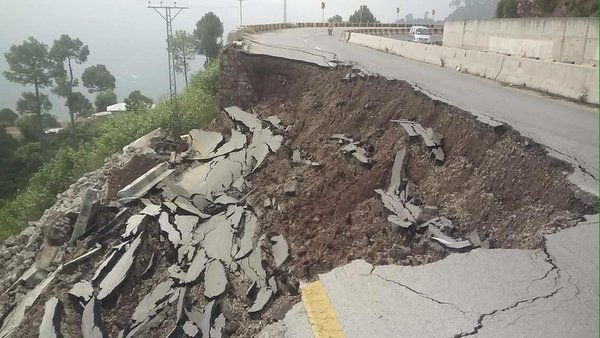The sliding down of a piece of land under the force of the gravitational pull of a mountain or hillside is called the landslide. It is a natural process which takes place in form of downward mass movements of rock, debris, and soil due to gravity influence. Itis a most attention taking natural disaster which mostly existed in hilly areas but recently increased in frequency in certain areas because of human activity. Water from heavy rainfall and Excessive waterare the frequent cause for landslides which weakens the slope materials.Other factors that weaken slope materials also contribute to the occurrence of landslides. The factors that weaken slope materials also contribute to the occurrence of landslides include both natural events such as geological weathering and erosion and human-related activities such as deforestation and changes made to the flow of groundwater while slope is also most common factor. Destruction of vegetation by droughts, fires, and logging has been associated with increased risk for landslides. One particularly destructive type of landslide is known as a lahar. Lahars are volcanic mud flows or debris flows that are capable of traveling at very fast speeds down the slope of a volcano.
Causes of Landslides
- Natural
Earthquake- Seismic activities have always been a main cause of landslides throughout the world. Any time plate tectonics move the soil that covers them moves with it. When earthquakes occur on areas with steep slopes, many times the soil slips causing landslides. Furthermore, ashen debris flows caused by earthquakes can also trigger mass movement of soil.
Heavy Rainfall: When sloped areas become completely saturated by heavy rainfall many times landslides can occur. Without the aid of mechanical root support the soil simply runs off when it contains too much water.
- Human causes
Clear Cutting: Method of timber harvesting which completely removes all old growth timber from the area. This method is hazardous because it destroys the existing mechanical root structure in the area and loosens the soil easily.
Mining: Mining operations that use blasting techniques often cause other areas that are at the risk of sliding to slide due to vibrations under the soil.
Landslides Preventing Measures
- Afforestation:Afforestation should be promoted, restrict the deforestationand intensive grazing by domestic animals should be avoided.It also helps to protect against soil erosion and flooding but its proper management required.
- Slope Vegetation:One of the quickest and easiest ways to prevent a landslide on a slope is to vegetate it. This landslide prevention method works best on slopes that are not too steep or if the movement hasn't already begun. You can do this method yourself by planting a groundcover or hire a landscaper to vegetate the slope.
- Retaining Walls:A solid, well-designed retaining should be made of sturdy materials such as masonry, brick, stone or steel. Drainage materials behind the wall help increase the stability of the wall.
- Diverting Debri Pathways:Building pathways to divert debris is another option to prevent landslides. You can create these pathways with the help of retaining walls. However, if you build walls to divert debris flow and then that flow lands on a neighbor's property, you can be liable for damage.
- Terrace Farming:Terrace is a piece of sloped plane that has been cut into a series of successively reducing flat surfaces or platforms, which resemble steps, for the purposes of more effective farming. This type of landscaping is therefore called terracing. Graduated terrace steps are commonly used to farm on hilly or mountainous terrain which helps to decrease both erosion and surface runoff and prevents landsliding.
- Construction of roads and dams should be restricted to fragile areas.
- People should be aware of the cause of the landslide.
- Temporary Prevention:For temporary landslide prevention, sandbags can be used to divert water from uncontrolled spilling just as retaining walls or diverted pathways do. Another method is to protect unstable areas with plastic sheeting, tarps or even burlap, especially in areas without vegetation because of recent fires.
